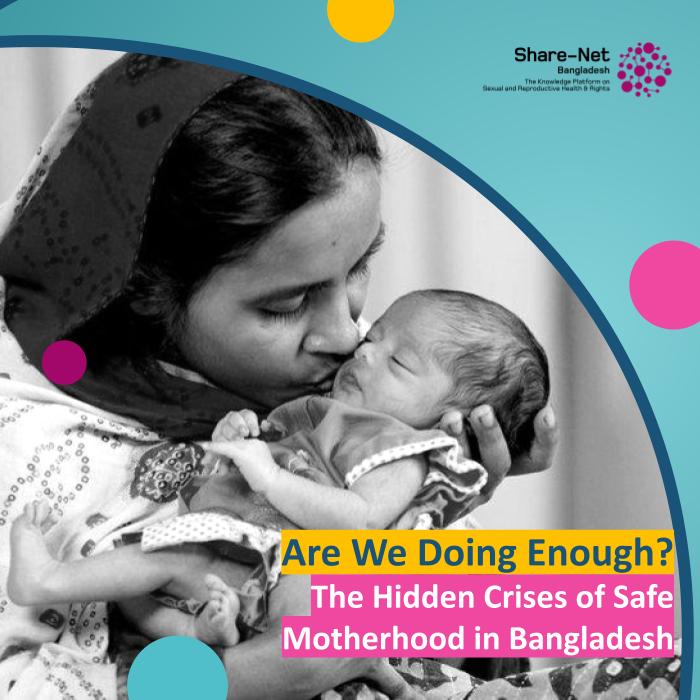Are We Doing Enough? The Hidden Crises of Safe Motherhood in Bangladesh
While the world was celebrating Menstrual Hygiene Day, yesterday was also Safe Motherhood Day. This year, the Health and Family Welfare Ministry set the theme “Make baby delivery in hospitals, save mothers’ and newborns’ lives.” However, the reality for many expectant mothers in Bangladesh tells a more complex story. High-risk pregnancies are on the rise, and despite the government’s efforts, the healthcare system is struggling to keep up with the demands of ensuring safe deliveries for all.
“Facing pregnancy-induced hypertension, gestational diabetes, and obesity, I struggled with placental insufficiency—my baby wasn’t getting enough nutrition,” recounts Sabina Yasmin, a mother who endured a high-risk pregnancy. Her story is not unique; in 2023, 38% of 124,557 obstetric patients in Bangladesh’s medical college hospitals experienced high-risk pregnancies.
This alarming rise in high-risk pregnancies underscores the urgent need to address sexual and reproductive health and rights (SRHR) and ensure safe motherhood. As Bangladesh aims to achieve the Sustainable Development Goal (SDG) 3, which targets good health and well-being, the healthcare system must adapt to manage and mitigate high-risk pregnancies effectively.
The Challenges of High-Risk Pregnancies
High-risk pregnancies are characterised by complications such as chronic health conditions, advanced maternal age, teenage pregnancy, and lifestyle factors like smoking and substance abuse. Dr. Raunak Jahan, an assistant professor at Shaheed Suhrawardy Medical College, highlights that such pregnancies require meticulous monitoring to ensure the health of both mother and baby. These complications can lead to severe outcomes, including high blood pressure, preterm birth, and even fatalities.
Despite the efforts, the maternal mortality rate in Bangladesh remains a concern, with 531 maternal deaths recorded in 2023 from approximately 98,000 deliveries. This statistic is a stark reminder of the gaps in maternal healthcare, especially for high-risk pregnancies.
Shortage of Skilled Providers
The increasing number of high-risk pregnancies strains an already overburdened healthcare system. Bangladesh faces a significant shortage of specialists, particularly in rural areas. With around 3.6 million pregnancies annually, the current ratio of one doctor for every 2,374 pregnant women falls short of providing adequate care.
Dr. Raunak notes that only a handful of medical colleges offer feto-maternal medicine positions to manage high-risk pregnancies. Rural areas are particularly underserved, often delaying critical care until a crisis occurs.
The Ever-Increasing Financial Burden
High-risk pregnancies are not only physically and emotionally taxing but also financially draining. The need for specialised tests, frequent monitoring, and medications can lead to exorbitant medical bills. For instance, Sajida Islam Parul, who faced a high-risk pregnancy due to diabetes and other complications, had to borrow over Tk 1.5 lakh and mortgage her wedding gold to afford her treatment.
Then there is the Surge of C-Section
Amidst all the above situations, another particularly pressing issue is the excessive rate of C-sections in Bangladesh. Although C-sections can be life-saving when medically necessary, the current trend of unnecessary C-sections poses significant health risks to mothers. Over-reliance on surgical births can lead to complications such as infections, increased recovery time, and long-term reproductive health issues. To combat this, the government needs to increase awareness about the risks associated with non-essential C-sections. Public health campaigns, better training for healthcare providers, and strict guidelines for C-section indications are crucial steps in reducing this trend.
Also, what about the PPD
Postpartum depression (PPD) is another significant concern for maternal health in Bangladesh. Studies indicate that approximately 22% of new mothers in Bangladesh experience PPD, a condition that can severely impact both the mother and her newborn. PPD can lead to emotional distress, difficulties in mother-infant bonding, and developmental issues for the child. Despite its prevalence, awareness and resources for managing PPD remain limited. There is an urgent need for mental health support systems, including counseling services and community-based support groups, to help new mothers navigate this challenging period.
The Way Forward
To address these challenges, comprehensive strategies are essential. Dr. Raunak suggests implementing overseas training and local workshops for healthcare professionals to improve the management of high-risk pregnancies. She also recommends developing an app to identify and track high-risk pregnancies, establishing dedicated units in government hospitals, and subsidising essential medical services.
Moreover, promoting pre-pregnancy counseling, ensuring women conceive at the right age, and managing chronic health conditions can help prevent high-risk pregnancies. Enhanced access to prenatal care, awareness campaigns, and policy interventions are crucial steps towards achieving SDG 3 and ensuring safe motherhood.
Dr. Ferdousi Begum Flora, a renowned gynecologist, emphasises the need for improved deployment of doctors in rural areas. Providing adequate facilities and educational opportunities for their children could encourage more doctors to serve in these underserved regions.
On Safe Motherhood Day, it is imperative to recognise the rising challenges of high-risk pregnancies and take decisive action. By prioritising SRHR and implementing targeted interventions, we can ensure that every mother has the opportunity for a safe and healthy pregnancy, contributing to the broader goal of sustainable development.
Safe Motherhood Day highlights the critical need to address the rising challenges in maternal health care. From the increasing number of high-risk pregnancies to the excessive rate of unnecessary C-sections, it’s clear that more comprehensive strategies are needed. Now the question is, how can we, you-me-everybody, ensure that our mothers-sisters-daughters have the safe and stress-free motherhood they deserve? Maybe it’s high time that we should all put some time aside to think about it!
Source: The Daily Star
Picture Credit: UNICEF Bangladesh/X page



